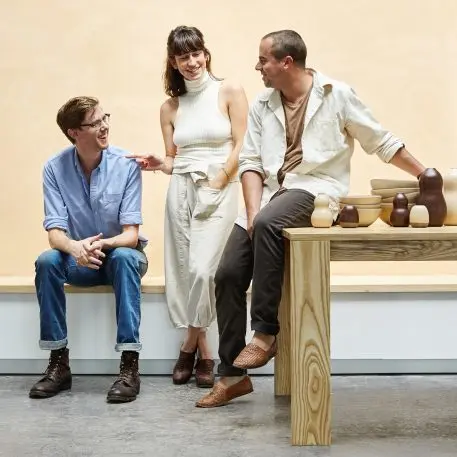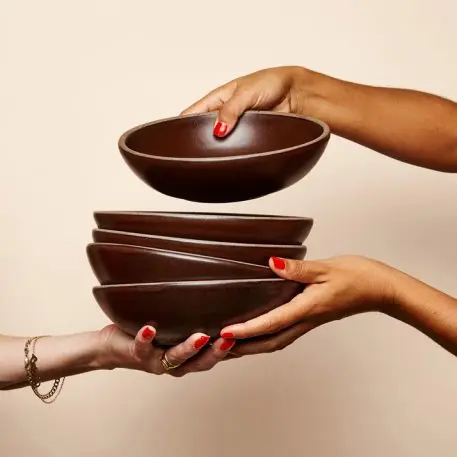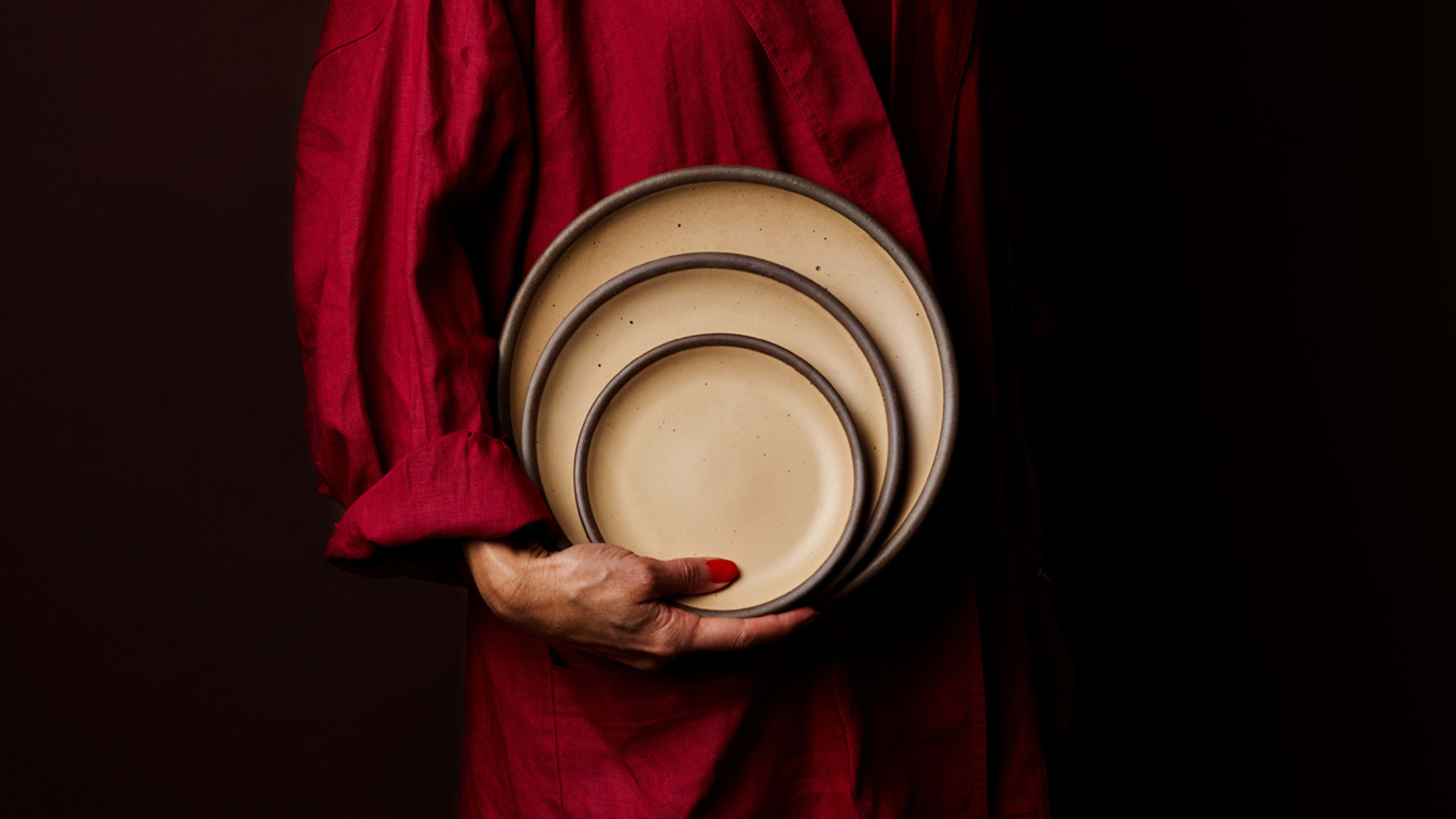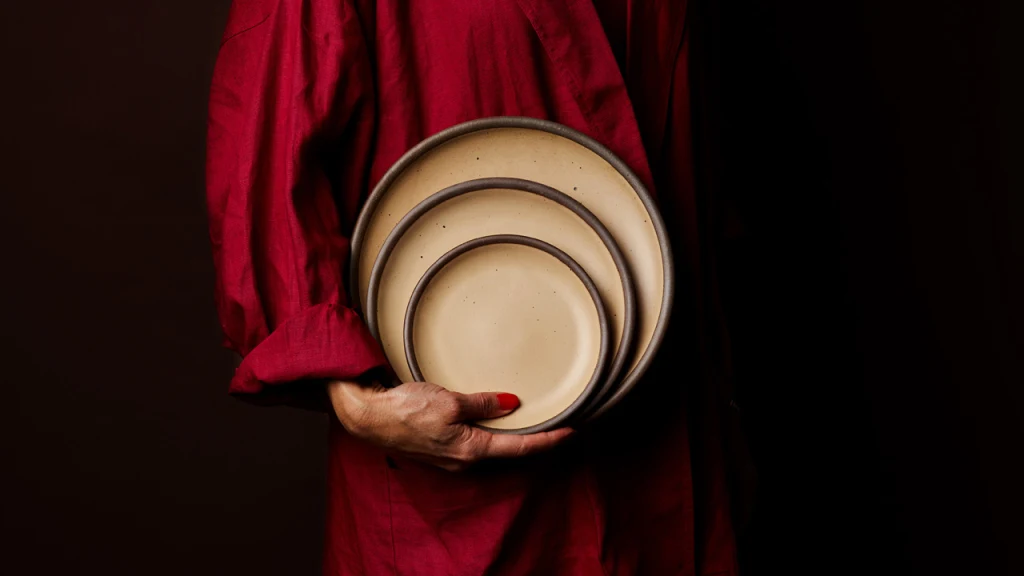In the summer of 2010, Alex Matisse–great grandson of the French modernist painter Henri Matisse–began laying bricks for a kiln in a farmyard on the foothills of North Carolina’s Blue Ridge Mountains.
These days, you can easily purchase an electric kiln that will turn your soft clay into pottery in a matter of hours. But Alex, then in his early twenties, was more interested in making pots the rustic, pre-industrial way. With the help of Connie–his then-girlfriend and now wife–he built an enclosed brick chamber that would allow you to fire clay up to temperatures of more than 2,500°F continuously for three days. “This is, as far as we know, how the earliest people created their clay pots,” Alex says. “Every culture has a version of fired pottery. I love that it is one of the most universal art forms.”


The boy who loved pottery
Alex was in a fourth-grade art class when he first fell in love with pottery. Even as a child, he loved the idea that he could make something with his hands that was both beautiful and usable.
Growing up in central Massachusetts, he was embracing a craft with rich local roots. Throughout the United States in the 1800s, hundreds of pottery studios and small factories sprang up, with potters handcrafting pieces that were both decorative and functional. Over time, pottery communities began to form in Massachusetts, Ohio, and North Carolina, where clay was abundant. But the vast majority of these potteries were forced to close when commercial kilns became widely available in the early 1900s. As with many other American industries, free trade agreements of the ’90s drove manufacturing to countries where labor was cheaper. As a result, today, most Americans eat food on generic-looking plates, mass-produced in places like China, Mexico, or Tunisia. Very few American potteries make ceramics at scale. There’s Los Angeles-based Bauer Pottery, founded in 1885, known for its pastel hues and ring patterns; West Virginia-based Fiesta, founded in 1936, famous for its bright Art Deco aesthetic; and Bay Area-based Heath Ceramics, founded in 1948, which produces earthy, minimal dinnerware used in restaurants like Chez Panisse and Park.
At 18, Alex moved to North Carolina, which has been home to a thriving pottery community since the 1950s. There, he apprenticed with a well-known potter named Mark Hewitt. While his friends were in college, Alex spent his days cleaning kiln shelves, mixing glazes, preparing their clay, and making the same pot over and over again until it was perfect.
Alex developed his own distinct style, which featured simple silhouettes, distinct rims, and geometric patterns on the glazes.
It took weeks of labor for Alex and Connie to build their own kiln. But the backbreaking work of laying bricks was a form of escape for Alex. In some ways, her was running away from a lifetime of carrying a heavy weight on his shoulders: Growing up as a Matisse comes with sometimes unreasonable expectations. “If you have any sort of creative inclination at all, your art will immediately be compared to Henri’s,” he says. “But how can anyone live up to the work of Henri Matisse?”
In 2011, Alex and Connie Matisse officially founded East Fork Pottery, named for the street their farm was on. (In 2013, they brought on their friend John, who had also apprenticed with a North Carolina potter, and now serves as CFO.) Unlike many potters, who often name their companies after themselves–Heath Ceramics is named for founder Edith Heath while Bauer Pottery is named for founder Andreas Bauer–Alex didn’t want the name Matisse connected to his business.
“I wanted to build something that was my own,” says Alex, who has taken on the role of East Fork’s CEO. “I wanted people to consider the pottery on its own terms.”

From art studio to Instagram bait
Alex, Connie, and John have transformed that small pottery studio into a thriving business with a cult following on the internet. They are inspired by fast-growing, millennial-oriented startup success stories, like Away, Allbirds, and Casper. They’ve also noticed a wave of new digitally native home brands, like Year&Day, Snowe, Great Jones, and Material Kitchen. East Fork clearly considers itself part of this wave, especially when it comes to branding. These days, when East Fork announces that it is launching a new color glaze for its vases, mugs, and plates, hundreds of people put themselves on the waitlist. Then, pieces sell out within hours of going live.
East Fork hit its stride three years ago, when the founders bought their first gas kiln to supplement the handmade brick kiln. John and Alex have focused on designing the visual identity for the pottery: They’ve developed a line of modern, minimalist ceramic tableware and vases that use North Carolina clay. Each piece is unique and speckled with little dots from the iron in the clay that becomes visible in the firing process. The pieces blend together rustic, handmade charm with a kind of industrial-chic look that appeals to many different aesthetic sensibilities.
Connie, East Fork’s creative director, has poured herself into creating a digitally native brand that will appeal to younger consumers who may not otherwise be drawn to pottery. The brand’s voice is funny and irreverent. The website is full of relatable photographs. A bowl is stacked with ice cream. Connie holds a side plate with a donut on it, while simultaneously breastfeeding her baby. Another image features the Matisses’ two toddlers eating pasta. “We want to be approachable,” she says. “We want to challenge people’s ideas about pottery as old-fashioned or granola, but we also don’t take ourselves too seriously.”
The direct-to-consumer model works particularly well for this kind of labor-intensive business. By cutting out the middleman markups that come with selling products at boutiques and department stores, East Fork is able to sell pottery at prices that are affordable. Bowls begin at $20, and mugs cost $36. It’s more expensive than a dinner set you would buy at Ikea or Target, but it’s not so outrageous you would be ashamed to put it on your wedding registry.
Today, the company has grown from the three founders to a team of 40, dozens of whom are involved with the actual crafting and manufacturing of the products. To date, East Fork has raised $2.6M in funding from angel investors, and is on track to be profitable by 2020. At the current pace, the founders expect to grow revenue by 300% over the next two years, and have a staff of nearly 100 in the next five.
To prepare for this growth, East Fork has moved into a new factory, which used to be a plumbing supply manufacturer. As you enter the newly remodeled building, you first see East Fork’s offices, which are reminiscent of the headquarters of many other hip, digitally native startups, like Everlane and Allbirds. The walls are lined with exposed brick, natural light fills the room, and there is a lot of open white space. The unadorned walls have the cold mystique of an art gallery. “I sometimes feel like we live halfway between two worlds,” Connie says. “We have one foot in the world of Warby Parker, and the other foot in the world of Asheville’s artist community.”

Made in America
In the light-filled factory, expertly trained potters stamp East Fork’s logo into soft clay that will become cups, bowls, and candle holders. It’s delicate, technical work that requires expertise. I watch Jessie Reinerth make plaster molds that give the final ceramics a consistent shape and size. She shapes the plaster with her hands, using her fingers to form a rim. “Much of the process is still done by hand, which isn’t true of most direct-to-consumer startups on the internet,” Alex says. “But we think that this handcrafting and attention to detail is what our customers are looking for, so we’re not about to take any shortcuts.”
East Fork is not entirely alone. Over the past few years, a couple of new startups committed to bringing manufacturing to the United States have cropped up. The founders of these companies each have their own reasons for making products locally.

East Fork’s founders have many reasons for making the products in North Carolina. Part of it is about investing in the local community: Alex has made this region his home for more than a decade, and wants to see it thrive. Part of it has to do with wanting to make sure that the products are well-crafted, and this is easier to do when the founders can walk a few feet from their desks to see how the glazes are looking today.
Perhaps the most crucial reason to make the ceramics in the United States is to continue an American craft pottery tradition that is rooted here in North Carolina. East Fork’s collection of products is designed to be sleek and modern–to appeal to young consumers who are buying houses and starting families. But whether those customers know it or not, the pieces are tied to very specific cultural lineage.
East Fork’s mugs and plates carry a philosophy of creating beauty in the simple, ordinary objects used every day, inspired by Shōji Hamada, who founded the Japanese folk art movement. And like the work of the well-known British potters Bernard Leach and Michael Cardew, who believed in using clay close to where the pots are made, East Fork sources its materials from the earth close to where the factory sits. East Fork is giving new life to these ideas.
A few weeks ago, East Fork took apart that brick kiln that Connie and Alex build with their own hands. They didn’t need it anymore, since they moved into their new factory. Connie observes that Alex spends less time making pots these days, although he still loves the craft. He’s evolved into the role of a business leader, and she thinks it suits him. “I think he’s been searching for his own creative identity,” she says. “And as a CEO, he’s found it. There’s a lot of creative energy that goes into running a company.”
Recognize your brand’s excellence by applying to this year’s Brands That Matter Awards before the early-rate deadline, May 3.









